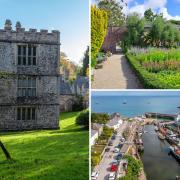Cornwall is stuffed with landmarks of its past - and its many blue plaques offer a taste of its rich history, writes Mica Bale...

Wouldn’t it be wonderful to have a window into the past? A window that opened the way to a glimpse into the world as it was decades, centuries or even millennia ago. A window that could be relied upon as a faithful witness into the events of yesterday. A window that told history as it really was. A window that was blue and round. A blue plaque. Although blue plaques might not be literal windows, there is still much to learn from the history they hold.
The idea of blue plaques and celebrating people, monuments, historical events and buildings came about in 1866. The first blue plaque to be unveiled was in 1867 and was awarded to Lord Byron’s birthplace however the house was demolished twenty years later making the earliest blue plaque to survive was a plaque commemorating Napoleon III who once lived in King Street off St James Square in London.
Cornwall boasts a rich record in blue plaques, there being more than thirty blue plaques throughout the county. Of course, despite their world renowned title, not all plaques are actually blue. Blue plaques come in browns, greens, greys and even black and are not always circular, some are rectangular or even squared. In fact, it was only after the Second World War that the most common blue plaque design came into being.
So, what about Cornwall? Well there have been more than just pirates in Penzance. In fact In Chapel Street there is a plaque commemorating Maria and Elizabeth Branwell. Who? Those two ladies contributed greatly to English Literature as they were mother and aunt of Emily, Anne, Charlotte and Branwell Brontë and were there through their formative years.

Not far away at No 4, Market Jew Street is a plaque which reminds us of the birthplace of Sir Humphry Davy who was not only a ground-breaking chemist but also an inventor and saved many lives with his Davy Lamp, designed to assist miners.
There are other plaques too in Penzance but the royal plaques may be found in Marazion where Charles II is said to have spent the night while he was on the run in the aftermath of the English Civil War. Prince Albert and Queen Victoria also visited Marazion in September 1846, admiring the view from St Michael’s Mount.
On Fish Strand Hill in Falmouth there is a plaque commemorating the arrival of Charles Darwin who landed in the town at the end of his five-year voyage on the famous HMS Beagle. He did not stay for very long as he was eager to get to London but nevertheless there is recognition that Falmouth was the first town to welcome him back.
Dolly Pentreath does not get forgotten as there is a black plaque in Mousehole to remind us of this grand lady who died in December 1777 and was considered to be the last person to speak Cornish as her native tongue. There has been a revival since of course but Dolly was the absolute real thing. While we are in Mousehole we must also mention the plaque dedicated to Squire Jenkyn Keigwin who was killed on 23 July 1595 while defending his home against invading Spaniards. Mousehole fell to the invaders but his home remained standing as it is to this day.
Also at the Ship Inn, Mousehole there is a plaque to commemorate the sacrifice of Les Greenhaugh and his crew who went down with the Solomon Browne lifeboat in the famous Penlee disaster of December 1981.
Meanwhile at Lizard Point we find a plaque in honour of Guglielmo Marconi who experimented with his radio signal research from a hut there in 1901. Thanks to Marconi it was also the place that received the first SOS signal sent by radio from a ship to shore.
Another pioneer was William Murdock who is remembered with a plaque in Cross Street, Redruth where he not only invented the first steam locomotive but also gas lighting which he installed in the house in 1792. There must be something about the Cornish air that makes people inventive. Richard Trevithick was another – an engineering genius who is recognised by a plaque at the White Hart Hotel in Hayle. Sport is not forgotten as there is a blue plaque at 61, Weldron Street, Helston commemorating the fame of Robert Fitzsimmons who was born there. Robert – or Bob as he is better known – won the world boxing championship at three different weight divisions, the first to do city. Although a gentleman out of the ring he was a natural fighter inside and the pride of Cornwall and Britain.
Perhaps one of the most exciting plaques is on the site of the restored Huer’s Hut which overlooks Newquay. The plaque explains that this 14th century building is basically a look-out hut, not to warn of an enemy but to tell the fishing folk that there was a large shoal of pilchards close to land thus launching the boats to harvest the fish. Imagine the sudden burst of activity when the call went out from the Huer’s Hut.
There are many more plaques of varied hues and colours in the county, all worth exploring.
How many times do we walk past plaques, blue or otherwise and not really give them a second glance and yet, they really do provide us with such windows into the past into a world of the rich and famous, the poor but defiant, the creators, the inventors, the military and civilian heroes and even some of the entertainers and a few of the villains.



























